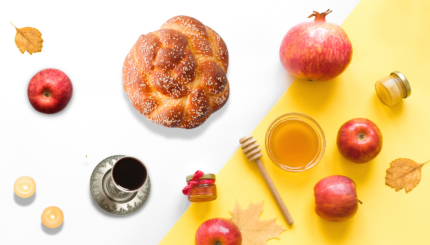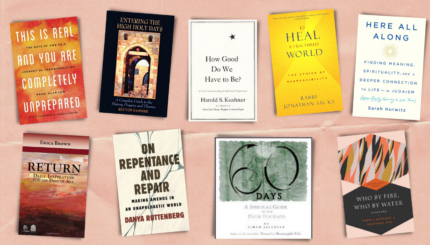מִן-הַמֵּצַר, קָרָאתִי יָּהּ; עָנָנִי בַמֶּרְחָב יָהּ
Out of the tight place I called to the LORD; God answered me with great enlargement.
-Psalm 118:5
Rosh Hashanah is more than a New Year. It is the beginning of the Aseret Y’mei Teshuvah, the 10 Days of Repentance, or Return, during which Jews traditionally take an inventory of their own actions, and make apologies for misdeeds both to other people and to God.
When is Rosh Hashanah? Click here to find out!
The Shofar, the ram’s horn, is sounded on Rosh Hashanah to awaken each person’s soul to its state of disrepair, and its work of repentance. Each time the Shofar is blown, it sounds 9 notes, in 3 units of 3 calls each. Each “sandwich” begins with a Tekiah, a long note, followed by one of three sorts of short notes, and ends with another Tekiah. Many Jewish communities have a custom to blow 100 Shofar blasts for each day of Rosh Hashanah, divided into several sections, of which one is during the Torah service and another is during the Musaf service, the additional service for Shabbat and holidays. The final blast of each full set is Tekiah Gedolah, a Big Tekiah- one that lasts as long as the shofar blower’s breath can hold out.
This year has brought us to an awareness of how much work there is yet to do regarding race and racism in our communities and ourselves. The sound of the shofar breaks us open, and shows us where we need to process and heal. Moving through a set of Shofar blasts that includes all the different sounds of the shofar, this meditation brings us through the process of Teshuvah, of Return, focusing on difference and unity.
May it be your will G-d that you hear our prayers.
Tekiah: The first sound of the shofar blasts us from our complacency. We thought we were all united, unified, undistinguished. That first, single note breaks down our illusions. We are not whole like that one piercing note is whole. We know that we are separate, broken-apart from each other.
Shvarim-Teruah: We stutter, tremble. Now I see that I am different, distinguishable, separate. Am I less-than you? Am I alone here? How bad is the damage between us?
Tekiah: We grasp for the imagined unity. One note, one people. We hope, we aim for acceptance.
Tekiah: I reach out to you. Do you see me? The note pierces, crescendoes, and then stops.
Shevarim: Another look. Three separate notes ring out. We are so different. Cut off from each other- me from you from her. I see how different you are from me: skin, hair, clothes… Even our upbringings aren’t as similar as we had thought. How can I talk to you? How can you understand me?
Tekiah: I am heartbroken. I reach out to God. Perhaps God will accept me as I am.
Tekiah: In this world where I cannot truly see you, my friend, you, the person sitting next to me in the pew, you, my neighbor, how can I reach out? How can I understand? My soul cries out for connection.
Truah: We are so broken-apart, perhaps there is no hope. The more I look, the smaller the pieces seem to be. They are so small, they string together like beads on a string. How can I find that string that will bring us together?
Tekiah Gedolah: The Kotzker Rebbe taught that “There is nothing so whole as a broken heart”- Having seen how broken apart we are from each other, we can now begin to heal, to return to the wholeness that was once only imagined- and to make it real. The shofar breaks us apart, and then brings us back together- together with ourselves, together with God, and finally, in acceptance, together with each other.
Rosh Hashanah
Pronounced: roshe hah-SHAH-nah, also roshe ha-shah-NAH, Origin: Hebrew, the Jewish new year.
Shabbat
Pronounced: shuh-BAHT or shah-BAHT, Origin: Hebrew, the Sabbath, from sundown Friday to sundown Saturday.
shofar
Pronounced: sho-FAR or SHO-far, Origin: Hebrew, a ram’s horn that is sounded during the month of Elul, on Rosh Hashanah, and on Yom Kippur. It is mentioned numerous times in the Bible, in reference to its ceremonial use in the Temple and to its function as a signal-horn of war.
Torah
Pronunced: TORE-uh, Origin: Hebrew, the Five Books of Moses.



